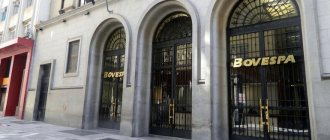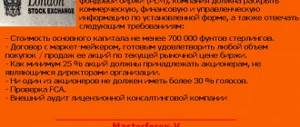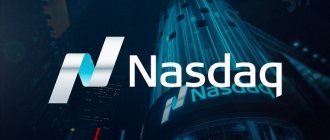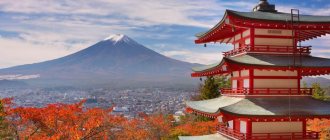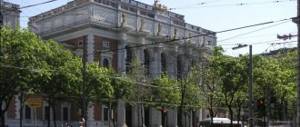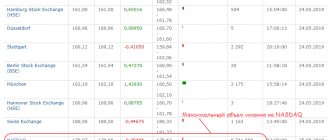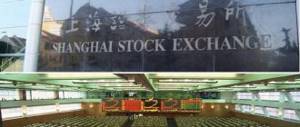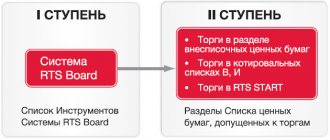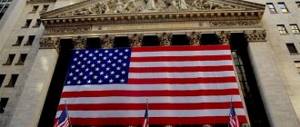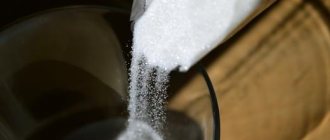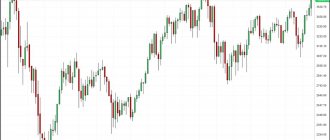| Bolsa de Valores, Mercadorias e Futuros de São Paulo | |
| Type | Stock Exchange |
| Location | Sao Paulo, Brazil |
| Year of foundation | 1890 |
| Currency | brazilian real |
| Number of companies listed | 365 |
| Stock indices | Ibovespa |
| Web site | [www.bmfbovespa.com.br www.bmfbovespa.com.br] |
Sao Paulo Stock Exchange
(port.
Bolsa de Valores, Mercadorias e Futuros de São Paulo
) or
Bovespa
(port.
Bovespa
) is the largest stock exchange in Latin America.
Located in the center of Brazil's largest city, Sao Paulo. In May 2008, Bovespa merged with the Brazilian Mercantile & Futures Exchange to
form
BM&FBOVESPA
.
Presentation of the Brasil Bolsa Balcao exchange and its main features
1. The Sao Paulo Stock Exchange is the largest in terms of capitalization of the securities market in all of Latin America (South and Central America). As of January 1, 2021, it was part of the “trillionaire club” (exchanges with a market capitalization of the securities market of over $1 trillion). However, the first quarter turned out to be extremely unsuccessful for B3 SA - the platform’s capitalization collapsed to $820.64 billion. As a result, it took 19th place in the author’s rating of the largest exchanges in the world from the Masterforex-V Academy (minus 2 positions) as of April 1, 2021.
- New York Stock Exchange – $23.211 trillion.
- NASDAQ: No. 2 stock exchange in the world – $11.218 trillion.
- Tokyo Stock Exchange – $5.608 trillion.
- Shanghai Stock Exchange SSE – $5.013 trillion.
- Hong Kong Stock Exchange HKE – $4.307 trillion.
- Euronext (Paris, Amsterdam, Brussels, Lisbon, Dublin) – $4.268 trillion.
- London Stock Exchange LSE – $3.965 trillion.
- Shenzhen Stock Exchange SZSE – $3.355 trillion.
- Toronto Stock Exchange – $2.216 trillion.
- Bombay Stock Exchange BSE – $2.179 trillion.
- National Stock Exchange of India – $2.156 trillion.
- Frankfurt Stock Exchange - $1.867 trillion.
- Swiss Stock Exchange - $1,603 billion;
- Korean Stock Exchange - $1,468 billion;
- OMX Group Nasdaq Nordic Exchange (Vilnius, Iceland, Copenhagen, Riga, Stockholm, Tallinn, Helsinki, Armenian stock exchanges) - $$1.432 trillion.
- Australian Stock Exchange ASX - $1.384 trillion.
- Taiwan TWSE - $1.041 trillion. =====================================================
- Johannesburg Stock Exchange (South Africa) - $950 billion;
- Sao Paulo Stock Exchange (Brazil) - $820 billion;
- Madrid Stock Exchange - $770 billion;
- Singapore Stock Exchange - $715 billion;
- Moscow Stock Exchange MOEX - $636 billion.
2. The rapid development of the Sao Paulo Stock Exchange began in 1965, when it ceased to be state-owned. The Brazilian Ministry of Finance retained only the functions of a financial regulator represented by the Brazilian Securities Commission (CVM), an analogue of the well-known and influential American SEC.
As a result, the influx of foreign capital began, and the rapid development of the exchange:
- since 1997, trading switched to the Mega Bolsa electronic system, thanks to which small and medium-sized investors began to take part in trading;
- branches opened in Rio de Janeiro, London and Shanghai;
- the over-the-counter securities market began operating;
- investors were offered to become co-owners of the Sao Paulo Stock Exchange, because its shares are traded in free circulation. The ticker symbol on the Sao Paulo Stock Exchange is B3 SASA3.
Listing conditions of the B3 SA exchange
To be listed on the Sao Paulo Stock Exchange, an issuer must meet a number of conditions:
- provide for free circulation at least 25% of the issue of its shares (the limit can be reduced to 15% if the average daily trading volume for the year is at least 25 million Brazilian reals ($6.44 million as of June 2021);
- the issuer's board of directors must have at least two (but not less than 20% of the total number) independent directors;
- the issuer must obtain permission from the state regulator (CVM).
Detailed listing conditions are provided on the corresponding page of the official website of the Sao Paulo Exchange: b3.com.br/en_us/regulation/regulatory-framework/listing/ (English version).
Negative factors
Brazilian and international economists had plenty of reasons to fear the worst. The COVID-19 pandemic has been a catastrophic blow, and Brazil is one of the hardest-hit countries both demographically and economically: since March last year, more than 8.9 million Brazilians have been infected with the new virus, of whom 219 thousand have died from complications. In terms of mortality from COVID-19, the country is second only to the United States, and in terms of the number of infected people in the world it is in third place after India.
Small businesses could not withstand the first wave of the pandemic, which brought with it restrictive measures and new costs. According to the Brazilian Institute of Geography and Statistics (IBGE), by July 2020 alone in Brazil, about 600 thousand small businesses had closed permanently due to the pandemic, and 950 thousand businesses had to lay off employees to stay afloat.
Over time, large businesses also began to experience serious problems - at the beginning of 2021, the American automaker Ford announced the closure of production in Brazil, following the example of Audi and Mercedez Benz, which reduced production capacity in the country.
Even according to official data (in Brazil, about 40% of the working-age population works in the shadow sector of the economy. - FAN note), business problems affected employment - by the end of 2021, the unemployment rate reached a record 14.3% or 14.1 million people. At the end of the year, 14 million Brazilian families (40 million people) fell below the extreme poverty line, with a per capita monthly income of less than $17, which was a record high since 2014.
Brazil's industry has had an extremely difficult year in 2021 - in March and April last year alone, industrial production fell by almost 29%, and from January to December this sector of the economy shrank by 5.5%. The hardest hit industries were automobile production (-31%), leather and footwear production (-21.5%), metallurgy (-9.8%) and textiles (-9.3%).
List of securities on the B3 SA stock exchange
Traded on the Sao Paulo Stock Exchange:
- commodity futures (coffee, ethanol, sugar, oil, soybeans, corn);
- gold futures;
- interest rate swap contracts (IPCA futures, spread futures);
- currency futures - US dollar (USD), Argentine peso, yen (JPY), euro (EUR), British pound (GBP), Russian ruble (RUB), etc.;
- Treasury bills (ten-year futures contract on US Treasury bills);
- government bonds;
- 16 largest ETF funds;
- 22 futures and stock options;
- 5 types of depository receipts;
- stock index futures (Brazil Index 50, Ibovespa, S&P 500, FTSE/JSE Top40);
- 387 common shares of listed companies (387);
- warrants;
- shares on the over-the-counter market (957), including: 34 OTC (organized over-the-counter market and 923 shares of companies not registered as issuers of securities on the São Paulo Stock Exchange.
Agree, there is a wide selection of tools for an investor to form an investment portfolio.
Blue chips of the B3 SA exchange and their Bovespa Index (Ibovespa)
The 13 blue chips of the Sao Paulo exchange are traditionally called. We give their capitalization for the 2nd quarter of 2021:
- PETROBRAS (ON) - capitalization $97.56 billion. Oil and gas sector. Daily oil production is about 2 million barrels. Until 1997, it was a monopolist and 100% owned by the state. Today the state influences the company through a controlling stake.
- Petroleo Brasileiro SA (PN) - $88.7 billion. The same company, only higher are ordinary shares, and here are preferred ones.
- Itau Unibanco Banco Holding SA – $87.74 billion. One of the largest Brazilian banking companies. It appeared in 2008 as a result of the merger of Holding Itaú Bancos and Unibanco. The bank operates in two dozen countries in America, Asia and Europe.
- Banco Santander Brasil SA Unit - $87.32 billion. Another large Brazilian bank. The IPO was held in October 2009.
- Banco Bradesco SA (preferred shares) - $76.70 billion. Number 3 in the Brazilian banking market. Shares are also traded on the New York and Madrid Stock Exchanges.
- Ambev SA - $70.31 billion. The largest brewing company in the country and one of the largest in the world.
- BRADESCO (ON) - $67.68 billion. The already mentioned Bradesco bank (No. 5), but ordinary shares.
- VALE - $64.87 billion Mining company. It is one of the largest in the world. Removed from state ownership in 1997. Shares are also traded on the NYSE, Euronext and the Hong Kong Stock Exchange.
- BRASIL (ON EJ NM) - $37.99 billion. Banco do Brasil is the largest bank in Brazil, founded under Portuguese rule. The majority stake belongs to the government.
- . Itausa Investimentos Itau SA - $26.99 billion. A large holding company that owns the Itau Unibanco bank, Duratex pulp and paper production, chemical enterprises, etc.
- TELEF BRASIL (PN EJ) - $21.70 billion. Telefonica Brasil is a large telecommunications group, a branch of the Spanish company Telefonica.
- Klabin - $20.52 billion. The country's largest manufacturer of paper and packaging.
- B3 SA SA Brasil Bolsa Balcao - $19.29 billion. Sao Paulo Stock Exchange.
The full list of shares is provided on the corresponding page of the official website: b3.com.br/en_us/products-and-services/trading/equities/listed-companies.htm
Economy of Brazil
Short story
Brazil's economy has experienced periodic booms and busts over the past few decades. The country's economy grew rapidly in the 1970s, but this growth was also accompanied by a significant increase in external debt. This led to further problems - in 1979, a surge in oil prices and a significant increase in US rates led to Brazil's trade balance going negative, the national currency devaluing, and debt servicing becoming expensive.
The 1980s and early 1990s as a result were a difficult period for the economy, during which the country experienced hyperinflation reaching hundreds and even thousands of percent per year. Rising prices gave rise to indexation of wages and pensions and created a vicious cycle. High inflation aggravated the situation of the poorest segments of the population, whose numbers continued to grow, while social inequality reached extremely high levels. It is also worth noting for a general understanding of the situation that until 1985 there was a military dictatorship in Brazil.
The economic situation in the 1980s was also aggravated by protectionist policies that severely limited imports. This was especially true for computers and other equipment - Brazil not only prohibited the import of modern equipment into the country for sale, but often even confiscated personal computers at the border from visitors from other countries under the pretext of fighting smuggling. Naturally, there was no local production of computers in the country; as a result, all document flow in the country took place on paper, which did not contribute to economic growth.
In 1994, Plano Real was implemented, which introduced a new currency in the form of the current Brazilian real, which at that time was pegged to the dollar. In addition, the state budget was made balanced - revenues had to cover expenses, which also reduced inflationary pressure. As a result, inflation fell from 2000%+ in 1994 to 16% in 1996 and 7% in 1997.
In 1997-1998 there was a difficult period for all developing countries against the backdrop of the economic crisis in Southeast Asia and the default in Russia. Brazil maintained slightly positive economic growth rates, but was forced to devalue the real. The country also raised a loan from the IMF to avoid default. At the same time, the real continued to devalue, including due to expectations that Lula da Silva from the Workers' Party would come to power and fears that he might reconsider the country's international obligations, which ultimately did not materialize.
The 2000s became a period of fairly rapid economic growth against the background of the growth of the economies of developing countries and a boom in commodity markets. Brazil was an exporter of a large number of commodities, from various agricultural products to iron ore, which contributed to the strengthening of the national currency and generally improving the economic situation. Oil production was also actively developing in the country, high prices for which also contributed to economic growth. In general, Brazil during this period of time attracted great interest from foreign investors, including thanks to the BRIC acronym that came into use, uniting the largest developing countries.
The crisis in 2008-2009 led to a slight decline, but in the early 2010s there was a new boom in commodity markets, which again supported the economy. However, in 2014, the country began to experience a rather protracted recession, accompanied by political scandals and the fight against corruption. The real was heavily devalued against the dollar, and GDP growth rates, even after emerging from the recession, remained low for a developing country, in the range of 1-2%, until 2021.
The 2014 Olympics and the FIFA World Cup brought attention to the country, but aggravated the state of the budget, which went into the red even without taking into account interest payments to service the debt.
If we talk about the current structure of the economy, agriculture plays a large role in Brazil, which accounts for a significant share of exports and the extraction of raw materials, primarily oil and iron ore. But at the same time, the country has a developed industry, including the production of cars, aircraft and other products. The picture below shows the structure of Brazilian exports.
Impact of coronavirus
The coronavirus had an expected negative impact on the economy - GDP fell by 10% at the moment.
8% of citizens lost their jobs, unemployment rose to 15%.
Since the beginning of 2021, the Brazilian real has depreciated by 40%+ against the US dollar by May 2021 and since then its rate has fluctuated in a fairly wide range around this level.
At the same time, the Central Bank of Brazil did not raise the rate in 2021, but rather reduced it to a record low 2%; back in 2021 it reached 14%.
Stock indices of the B3 SA exchange
Broad Indexes:
- Bovespa Index (Ibovespa) is the main index of the Sao Paulo Stock Exchange;
- Brazil 50 Index (IBrX 50) – the 50 most actively traded and most representative stocks of the Brazilian stock market;
- Brazil 100 Index (IBrX 100) – the hundred most actively traded and most representative shares of the Brazilian stock market;
- Brazil Broad-Based Index (IBrA) is a composite index that includes all shares of the exchange.
Corporate governance indices:
- Trade Index of Corporate Governance (IGCT);
- Novo Mercado Corporate Governance Index (IGC-NM);
- Special stock index of corporate governance (IGC);
- Special exchange index (ITAG).
Sectoral indices: Financials Index (IFNC) - shares of financial companies in Brazil; Industrials Index (INDX) - shares of industrial companies in Brazil; Dividend Index (IDIV) - companies with the highest dividends; Consumer Stock Index (ICON) - all companies on the Sao Paulo Stock Exchange, etc.
Sustainability indices: Index of Carbon Efficiency (ICO2) and Index of Corporate Sustainability (ISE).
Indices in partnership with the S&P 500: Fixed income indices; Future Indices; Product index; Non-SOE; Smart Betas, etc.
Brazil's Ibovespa stock index hit a new all-time high amid expectations that a major overhaul of the country's social security system will win congressional approval.
The index rose to 100,000 for the first time on Monday, pushing earnings up 14% this year.
"It's hard to find another story as positive as Brazil in the region," said Amy Shayo, JPMorgan's head of Latin America equity strategy. The holding's experts talk about a "virtuous cycle" amid tighter fiscal policy and loose monetary policy, as that kind of combination "attracts outside capital and also helps companies regain what they've lost in terms of profits," Chaillot said.
Expresso 01/09/2019 Estadão 02/12/2019 Much of investor optimism about Brazil stems from President Jair Bolsonaro's market-friendly agenda, which includes the privatization of inefficient and state-owned enterprises, fiscal reforms, and other measures aimed at support for Latin America's largest economy. Since Congress reconvened in February, investors have been closely watching how the new president will win lawmakers' support as he pushes through a controversial pension bill. Previous administrations failed to win approval for the proposal, which is seen as key to solving the budget deficit and ensuring a sustainable economic recovery.
"The pension bill should be approved by the lower house in June," said David Beker, Latin America equity strategist at Bank of America Merrill Lynch. Becker believes the Ibovespa index will be at 120,000 by the end of the year due to rising earnings and expectations of a better fiscal outlook.
Despite the recent record, foreign investors remain skeptical about the stock market rally, which has been largely supported by local players. Foreigners withdrew 597 million reais ($157 million) from Brazilian stocks as of March 14. Bloomberg experts came to this conclusion based on currency exchange data after the largest year-over-year outflow since the global financial crisis.
InoSMI materials contain assessments exclusively of foreign media and do not reflect the position of the InoSMI editorial staff.
Ibovespa is the main index of the B3 SA exchange
Analysts call the Ibovespa index one of the popular trading tools on the B3 SA exchange . It collected the most liquid shares of 50-60 (the number varies) companies, so it can be safely classified as a blue chip index.
The Ibovespa index basket is reviewed quarterly to ensure that the criteria set are up to date:
- shares must have been listed on the B3 SA stock exchange for at least 12 months (this excludes newly arrived companies that have not yet proven themselves);
- the trading share of shares of one company must exceed 0.1% of the total flow on the exchange;
- all shares in the index make up about 80% of the exchange’s capitalization;
- All stocks in the index account for about 80% of trades.
The Ibovespa index was first calculated in 1968. Over the decades, certain adjustments have been made to his calculations to better suit the spirit of the times. As a result, for almost half a century the Ibovespa index has acted as a reference point for investors from all over the world.
Traders and investors are offered a fairly wide range of tools for the best investment in Ibovespa:
- ETF funds;
- futures contract;
- futures contract for Mini Ibovespa;
- Options;
- FLEX Options;
- Rollovers;
- Rollovers on Mini Ibovespa.
Exchange Traded Funds ETFs and ETP Products on the São Paulo Exchange
There are 16 ETFs available for investment on the Sao Paulo Stock Exchange:
Full list on the corresponding page of the official website: b3.com.br/en_us/products-and-services/trading/equities/etf/equities/etfs-listed/
In addition, instruments such as options, rollovers, derivatives and futures contracts are available for many B3 SA exchange indices.
Masterforex-V recommendations for trading the Ibovespa index of the B3 SA exchange
- For investors. Ibovespa is one of those stock futures for which we recommend opening buy transactions for LONG-term (about ten years) investment on the expected Bullish impulse, as well as on the American indices Dow Jones 30 and S&P 500, Canadian S&P/TSX 60, British FTSE 100, because they are in 2009-2019. managed to update their historical highs of 2008. and gain a foothold ABOVE them.
- For traders . Ibovespa is a very interesting and volatile financial instrument for trading, if... you know the current strong and minor levels of order accumulation from the Masterforex-V Academy, some of which are shown in the following chart.
Professional traders of Masterforex-v work on different, and not on ONE market (Australian, Moscow, Swiss, London or New York exchange). What is important to a successful trader is not a specific market (stock, cryptocurrency, commodity, foreign exchange), but the trend, which varies by instrument in different months. So, in the current quarter the trend may be in EUR USD, USD CHF or GBP USD, in the next - in stocks and stock market indices, in the third in Bitcoin and cryptocurrencies, in the fourth - in futures and CFDs of cotton, copper, oil, gas, etc. .d. and so on.
It is by working in DIFFERENT markets that you can earn 300%-700% in a few years, like Masterforex-V traders according to the statistics of our Rebate - auto-copy service pro-rebate.com. Not a single bond, share, index, ETF or ETP fund can provide such a return for investors for any period in the history of their trading.
Choosing a broker for trading stock indices
The widest selection of financial instruments for working on DIFFERENT markets is presented by the English forex broker FxPro , which is one of the recommended brokers of our Rebate - autocopy service pro-rebate.com and the TOP rating of brokers of the Masterforex-V Academy.
The FxPro.com trading terminal contains:
- 141 “blue chip” shares - shares of companies in the USA, Great Britain, Germany, France, etc.;
- more than 70 forex currency pairs, including EUR USD, GBP USD, USD JPY, USD CHF, USD CAD, NZD USD, AUD USD, USD RUB, EUR RUB, USD SEK, USD NOK, etc.;
- 24 stock (exchange) indices, incl. South African FTSE/JSE Top 40 (JTOPI) - #South Africa40, Australian S&P/ASX 200 (#AUS200), Canadian S&P/TSX 60 (#Canada60), Japanese NIKKEI 225 (Japan225), Euro Stoxx 50 (#Euro50), American Dow Jones 30, NASDAQ-100, and S&P 500, Hong Kong Hang Seng 50 (#HongKong50), BSE SENSEX 30 (India), German DAX 30 (#Germany30), IBEX 35 (#Spain35), Swiss SMI 20. British FTSE 100 (#UK100), Chinese SSE 50,
The broker provides
- a trading platform familiar to all traders for Meta Trader 4 and Meta Trader 4 Mobile traders with the largest group of built-in indicators and oscillators for technical analysis of charts;
- minimum trading account from $100 (note: the minimum recommended deposit for money management MF is from $800-$1000 when trading 0.01 0 lot)
- leverage from 1:30 to 1:500;
- All types of trading strategies are allowed, from automated advisors to day trading, swing trading, scalping, etc.
The broker's trading accounts are insured up to 20,000 euros from the Investor Compensation Fund in case of bankruptcy of the company (compensation for non-trading risks).
When opening a real trading account from $3000 with FxPro, a trader receives the opportunity to study for free for 1 year at the Masterforex-V Academy.
Successful trading systems for making a profit on the main exchange of Brazil
If you have not studied at the Masterforex-V Academy, we suggest you carefully study and save several reliable trading systems with MF know-how:
- Scalping (Scalping: classics and Masterforex-V strategies) – for trading on timeframes m1 and m5;
- Swing trading (Swing trading: classics and know-how Masterforex-V) – for trading on time frames on m30 – n4;
- “3 Elder screens” (three Elder screens and Masterforex-V modifications) – for comprehensive market analysis;
- What did Masterforex-V change in Bill Williams’ trading strategy to make it work?
- Basics of classic Elliott wave analysis and MasterForex-V know-how;
- 7 know-how of money management MasterForex-V: how to get maximum profit on Forex with minimal risk
Exchange B3 SA and cryptocurrencies
Cryptocurrencies are not traded on the B3 SA exchange. At the same time, the Brazilian digital currency market is developing dynamically. So on April 10, 2021, the total trading volume reached 100,000 BTC.
The growing popularity and development of specialized crypto exchanges has led to increased control by the Brazilian Federal Budget Department. From now on, the crypto market regulator wants to receive reports on internal cryptocurrency transactions on a monthly basis. In addition, local users making transactions on foreign platforms must report such transactions if their monthly volume exceeds 10,000 reais ($2.58 thousand).
The largest crypto exchanges in Brazil: Bitcointrade, Mercado Bitcoin, Foxbit.
Interesting facts about the B3 SA exchange
- The exchange changed its name several times:
- Sao Paulo Stock Exchange (Bovespa);
- BM&FBOVESPA since May 8, 2008 (after merger with Brazilian Mercantile and Futures);
- B3 SA from March 30, 2021 (after merger with CETIP).
- In 2008, the Sao Paulo exchange and the Chicago Mercantile Exchange CME exchanged 5 percent stakes.
- On October 21, 2002, law enforcement officers prevented a major terrorist attack on the Sao Paulo stock exchange. The terrorists were going to detonate a homemade bomb with a capacity of 30 kg of TNT in the exchange building. A terrorist attack would lead to chaos in the financial market not only of Brazil, but of all of Latin America.
Political battles
The prolonged political crisis also does not inspire confidence in national and international investors. The past year was marked by confrontation between the government and the chambers of Congress, high-profile resignations of the ministers of health, education and tourism, and corruption scandals involving officials close to government circles.
In 2021 alone, about 50 requests for impeachment of Jair Bolsonaro were sent to the Chamber of Deputies, who was also complained to several times in international courts with accusations of genocide and a frivolous attitude towards the health of the nation.
Opening hours of the B3 SA exchange
Sao Paulo Stock Exchange (B3 SA) opening hours:
09:45-10:00 – pre-sale session; 10:00-17:30 – trading session; 18:00-19:30 – post-market session.
The exchange operates on weekdays (Monday to Friday). It may also work on weekends; market participants are informed about this in advance.
Best regards, wiki Masterforex-V.
Crime chronicle
The court found a native of the state of Parana guilty of the murder of a twelve-year-old boy in Rio Grande do Sul.
The murdered boy, Ederson Leite, was the first in a series of murders since September 2002. The accused, Adriano da Silva, confessed to 12 murders. Since Brazil does not have the death penalty, his sentence, once he is found guilty of all crimes, will be 193 years.
https://g1.globo.com/Noticias/Brasil/0,,MUL860027-5598,00.html
In the state of Minas Gerais in the city of Alfenas, a teenager was detained at school with a loaded firearm in his backpack.
The parents will face two charges of possession of an unregistered weapon and reckless handling of weapons, police said.
Guns among children are a serious problem in Brazil, where, especially in poor areas, children are often used in gang warfare and robberies.
https://g1.globo.com/Noticias/Brasil/0,,MUL860157-5598,00.html
